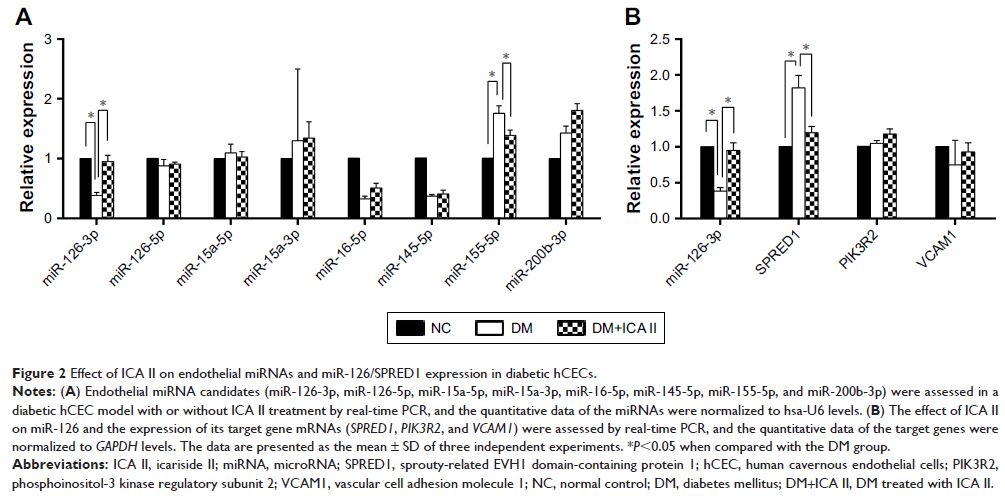108605
论文已发表
注册即可获取德孚的最新动态
IF 收录期刊
- 3.4 Breast Cancer (Dove Med Press)
- 3.2 Clin Epidemiol
- 2.6 Cancer Manag Res
- 2.9 Infect Drug Resist
- 3.7 Clin Interv Aging
- 5.1 Drug Des Dev Ther
- 3.1 Int J Chronic Obstr
- 6.6 Int J Nanomed
- 2.6 Int J Women's Health
- 2.9 Neuropsych Dis Treat
- 2.8 OncoTargets Ther
- 2.0 Patient Prefer Adher
- 2.2 Ther Clin Risk Manag
- 2.5 J Pain Res
- 3.0 Diabet Metab Synd Ob
- 3.2 Psychol Res Behav Ma
- 3.4 Nat Sci Sleep
- 1.8 Pharmgenomics Pers Med
- 2.0 Risk Manag Healthc Policy
- 4.1 J Inflamm Res
- 2.0 Int J Gen Med
- 3.4 J Hepatocell Carcinoma
- 3.0 J Asthma Allergy
- 2.2 Clin Cosmet Investig Dermatol
- 2.4 J Multidiscip Healthc

淫羊藿次苷 II 通过在糖尿病人海绵体内皮细胞中的 miR-126/SPRED1 来调节 MAPK 通路,从而减轻内皮功能障碍
Authors Lei H, Li H, Tian L, Li M, Xin Z, Zhang X, Guan R
Received 27 February 2018
Accepted for publication 23 April 2018
Published 13 June 2018 Volume 2018:12 Pages 1743—1751
DOI https://doi.org/10.2147/DDDT.S166734
Checked for plagiarism Yes
Review by Single-blind
Peer reviewers approved by Dr Cristina Weinberg
Peer reviewer comments 3
Editor who approved publication: Dr Anastasios Lymperopoulos
Aim: The aim of the study was to investigate whether miR-126, a
regulator of MAPK signaling via targeting sprouty-related EVH1
domain-containing protein 1 (SPRED1 ) mRNA, is
involved in the process by which icariside II (ICA II) ameliorates endothelial
dysfunction in human cavernous endothelial cells (hCECs) exposed to a
diabetic-like environment.
Materials and methods: Primary hCECs were isolated and divided into
three groups, normal control, diabetes mellitus (DM), and DM treated with ICA
II. The cell proliferation and migration abilities of the hCECs were examined.
The expression levels of endothelial-related microRNAs and relative target
mRNAs (SPRED1 , phosphoinositol-3 kinase
regulatory subunit 2, and vascular cell adhesion molecule 1) of miR-126 were
determined by real-time PCR. The protein expression of endothelial nitric oxide
synthase, receptor for advanced glycation end products, and SPRED1, and MAPK
signaling activities was determined by Western blot analysis. In addition, miR-126
agomir and antagomir were used for transfection into hCECs to further testify
the association between miR-126 and its targeting mRNA SPRED1 .
Results: hCECs induced with glucose plus advanced
glycation end product-BSA showed a significant decrease in endothelial nitric
oxide synthase, Ki-67, and miR-126 expression; a downregulated cell migration
ability and an increased receptor for advanced glycation end products level.
ICA II could partially reverse these changes. SPRED1 mRNA
showed a contrary tendency with the miR-126-3p changes. The level of SPRED1
protein increased after the hCECs were induced with glucose plus advanced
glycation end product-BSA, and ICA II could rescue its aberrant expression. In
addition, the MAPK pathway was downregulated in the hCECs under diabetic
conditions, and ICA II could partially enhance its signaling activities.
miR-126 was obviously downregulated, and SPRED1 was
accordingly upregulated after miR-126 antagomir transfection, while ICA II
treatment could recover the expressions of both miR-126 and SPRED1 . Moreover, the upregulation
of miR-126 and the inhibition of SPRED1 were
noticed in the diabetic hCECs by further transfection with miR-126 agomir.
Conclusion: ICA II could ameliorate endothelial dysfunction by
regulating the MAPK pathway via miR-126/SPRED1 in hCECs exposed to a
diabetic-like environment, and ICA II might be a protective agent for
endothelial function in diabetic ED.
Keywords: human cavernous
endothelial cells, endothelial dysfunction, miR-126, diabetes mellitus,
icariside II
